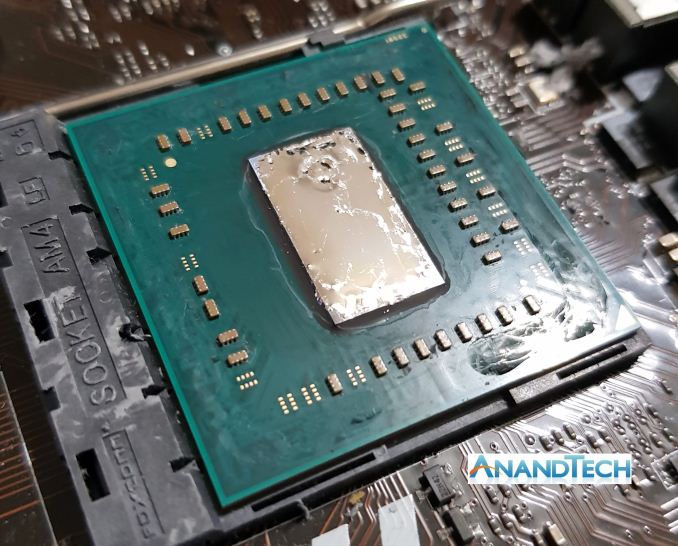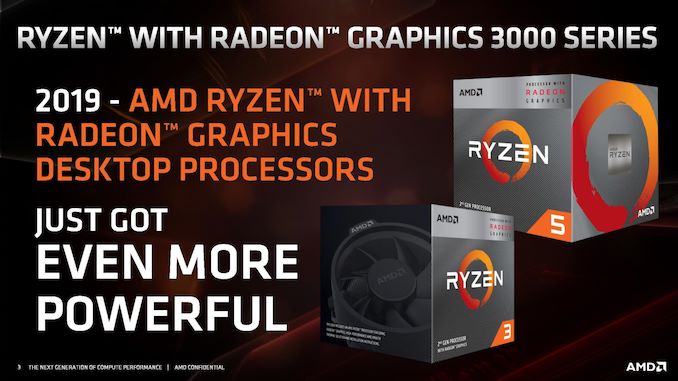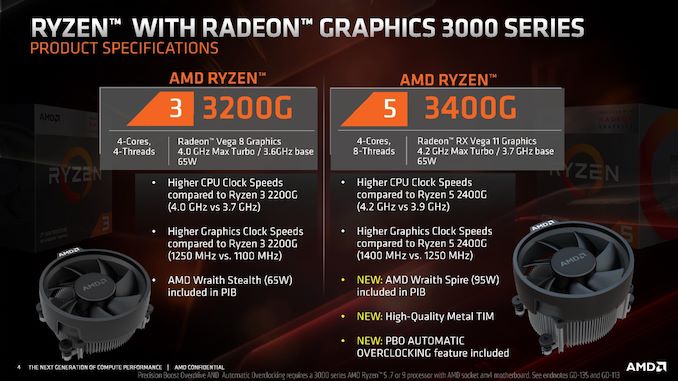AMD Ryzen 3000 APUs: Up to Vega 11, More MHz, Under $150, Coming July 7th
by Dr. Ian Cutress on June 10, 2019 7:40 PM EST
The integrated graphics ‘APU’ line of processors from AMD is a popular entry point for consumers on a budget based on the good performance from the cores, gaming-capable graphics, and all for a reasonable low cost that also comes bundled with a very sufficient cooler. AMD’s APU line is one lock-step behind its leading edge CPU technology, so this time around the new Ryzen 3000 APUs are built on last generation Zen+ 12nm technology, but with increased IPC, clock speeds, and an overall performance bump.
So truth be told, I’m a sucker for a good low cost entry-level processor. If you can provide me good performance and good gaming at a low price, then it becomes my go-to suggestion for low-cost builds to family and friends. These users might not need a discrete graphics card, but they need something to do desktop tasks with, and potentially game, without missing a beat. For the last generation, as seen from my CPU guides, AMD’s first generation Zen APUs filled that role. This will change come July 7th, as AMD will launch its Zen+ APUs to replace them.
| AMD Ryzen APUs | ||||||||
| AnandTech | Cores | Base Freq |
Turbo Freq |
IGP | IGP Freq |
DDR4 | TDP | Price |
| Ryzen 3000 'Zen+' | ||||||||
| Ryzen 5 3400G | 4C / 8T | 3.7 | 4.2 | Vega 11 | 1400 | 2933 | 65W | $149 |
| Ryzen 3 3200G | 4C / 4T | 3.6 | 4.0 | Vega 8 | 1250 | 2933 | 65W | $99 |
| Ryzen 2000 'Zen' | ||||||||
| Ryzen 5 2400G | 4C / 8T | 3.6 | 3.9 | Vega 11 | 1250 | 2933 | 65W | $159 |
| Ryzen 3 2200G | 4C / 4T | 3.5 | 3.7 | Vega 8 | 1100 | 2933 | 65W | $99 |
The Ryzen 5 3400G and Ryzen 3 3200G replace the 2400G and 2200G counterparts in the product line and offer two new speed jumps. The Zen+ architecture used in the new CPUs will offer a raw +3% throughput increase (IPC) in compute performance, as we saw when the main processor line moved from Zen to Zen+. The other factor is frequency – both new CPUs gain +300 MHz on the turbo frequency compared to the previous generation, as well as a +150 MHz increase in graphics frequency, all at the same power budget. The new APUs also support DDR4-2933, which will help with performance.
The other added bonus will be to the Ryzen 5 3400G, which will not only be released $10 lower than the 2400G, but it will now come with the 95W AMD Wraith Spire CPU cooler bundled in box, an upgrade over the 65W version previously used. This CPU will also be Indium-Tin soldered on for better thermal performance and potential in overclocking headroom.
A new feature coming to the APUs is support for 4K protected video streaming, such as Netflix 4K. This is a feature that has been missed on the previous generation, especially as AMD’s APUs have found their way into a number of small form factor systems and HTPC builds. The new APUs also support Radeon Anti-Lag, a new feature to reduce controller-to-display lag input times.
These CPUs are still PCIe 3.0, because they are one generation behind AMD's mainstream processors.
AMD’s messaging on these new APUs is that they will provide the best and most powerful integrated graphics on a desktop processor. With no competition in this segment, this is likely to be true. The processors are set to be launched on July 7th with the other members of the Ryzen 3000 family.
Related Reading
- ASRock Confirms Support for Ryzen 3000 APUs in DeskMini A300 SFF System
- Zen and Vega DDR4 Memory Scaling on AMD's APUs
- AMD Launches Ryzen Pro with Vega: Mobile APUs and Desktop APUs
- Delidding The AMD Ryzen 5 2400G APU: How To Guide and Results
- AMD Launches Ryzen 3 2200GE & Ryzen 5 2400GE 35 W APUs
- Overclocking The AMD Ryzen APUs: Guide and Results
- AMD Ryzen 5 2400G and Ryzen 3 2200G Integrated Graphics Frequency Scaling
- AMD Ryzen 5 2400G and Ryzen 3 2200G Core Frequency Scaling: An Analysis
- Marrying Vega and Zen: The AMD Ryzen 5 2400G Review













59 Comments
View All Comments
AshlayW - Monday, June 10, 2019 - link
These are likely to demolish Intel's new Ice-Lake iGPU, the 3700U comparison made was unfair with the AMD part using single-channel memory.danielfranklin - Monday, June 10, 2019 - link
You have a lot of faith in old architectures and a 10% clock bump with no additional memory bandwith.If Intel cant beat this with their new huge GPUs and LPDDR4x we are in trouble.
wilsonkf - Monday, June 10, 2019 - link
Vega 11 of desktop APU is by no mean weaker than Ice-Lake iGPU. Intel's test on mobile APU with handicapped memory config does not mean a thing for desktop.TheUnhandledException - Monday, June 10, 2019 - link
Well given that Intel totally biased the benchmark (60% higher memory bandwidth, 30% higher SSD sequential reads, 70% higher SSD random reads) and despite that only got 96% to 116% the performance of the last gen Ryzen APU AMD doesn't need much to win real world.Jorgp2 - Tuesday, June 11, 2019 - link
The APU was running just as AMD designed it.0ldman79 - Tuesday, June 11, 2019 - link
So it was dual channel then?notashill - Tuesday, June 11, 2019 - link
https://twitter.com/ryanshrout/status/113296065573...According to Intel, yes.
0ldman79 - Sunday, June 16, 2019 - link
Thanks for clearing that up.azfacea - Monday, June 10, 2019 - link
what intel GPUs. you mean the 10nm parts that dont exist. Bigfoot is more likely to surface than intel 10nm (not counting marketing stunts and fake launches)Santoval - Tuesday, June 11, 2019 - link
Ice Lake's iGPUs might work OK (not all of them, only the 48 & 64-shader parts), but bear in mind that it was reported that Ice Lake-U will have a mere 3 - 4% higher single thread performance than the equivalent Whiskey Lake-U by none other than Intel themselves. So the true value is surely even lower.Ice Lake-U has a modestly higher IPC than Whiskey Lake-U - we do not know how modest exactly, since Intel only compared it to the IPC of the ... original Skylake of 2015. However Intel's crappy 10nm+ node still has severe thermal and clock issues. So the node's very low clocks ate all (or nearly all) the IPC gains.
Which is why Intel focused on iGPU performance, AI performance and ... "Wi-Fi performance" in their Computex presentation and basically buried the CPU performance in a single graph where they compared Ice Lake-U (along with Whiskey Lake-U and the predecessors) to... Broadlake.
It is also why there is still no word about when mid and full power Ice Lake CPUs will be released (they probably won't - word is they'll need to wait for Intel's 10nm++ node, i.e. the Tiger Lake release) and why Comet Lake (up to -U at least, despite the overlap with Ice Lake-U) was introduced. No matter how Intel tried to mask and decorate it, they still have serious 10nm node issues, largely due to the extreme complexity they introduced to that node.